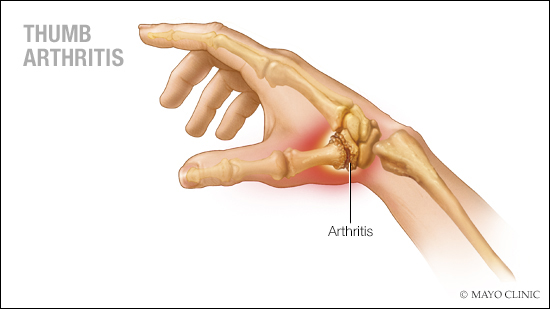-
Featured News
Mayo Clinic Q and A: Treating thumb arthritis
 DEAR MAYO CLINIC: What can be done about thumb arthritis besides having surgery to relieve the pain?
DEAR MAYO CLINIC: What can be done about thumb arthritis besides having surgery to relieve the pain?
ANSWER: There are a number of therapies to consider before turning to surgery to treat thumb arthritis. Although these therapies may not always provide long-term relief, for most people with thumb arthritis, they can effectively lessen symptoms, and surgery may not be necessary. Surgery for arthritis of the thumb is usually a treatment of last resort.
The thumb is designed to give you a wide range of motion, enabling you to pinch, grip and grasp objects. It provides approximately 40 percent of hand function. In a normal thumb basilar joint, the cartilage that covers the ends of the bones acts as a cushion and allows the bones to glide smoothly against each other. With thumb arthritis, the cartilage that covers the ends of the bones deteriorates, and its smooth surface roughens. The bones then rub against each other, resulting in friction and more joint damage.
The most common symptom of thumb arthritis is pain at the base of your thumb during daily activities, such as opening a jar, turning a key or pulling a zipper. You may notice other symptoms, too, such as stiffness, tenderness or swelling at the base of your thumb. You may not have as much range of motion or strength in your thumb as usual.
About 8 to 12 percent of the population is affected by arthritis of the thumb joint, making it the second-most common part of the hand to have arthritis. The joints at the end of the fingers are the most common spot for hand arthritis. Thumb arthritis affects more than half of women 70 and older.
Simple, at-home treatments may be all that are needed for some people to reduce symptoms of thumb arthritis successfully. Anti-inflammatory medication, such as ibuprofen, is often effective. A gel form of a similar anti-inflammatory medication (the prescription diclofenac) is available for those whose stomachs do not tolerate anti-inflammatories well. Other medications, including acetaminophen and prescription pain relievers, also may help.
In addition to medications, tools that make it easier for you to grip with your thumb can be useful. Jar openers, key turners and large zipper pulls designed for people with limited hand strength are available. Many people with thumb arthritis also find it helpful to replace traditional round door handles with lever handles. Your health care provider or a hand therapist may have other suggestions about techniques and equipment that can make it easier to use your thumb.
If those steps aren’t enough, talk to your health care provider about getting a splint that can support your joint, and limit your thumb and wrist movement. Doing so helps rest the thumb joint and lessens pain. Some people only need to wear a splint at night. But, depending on your situation, your health care provider may recommend prolonged use of a splint, especially when you do activities that cause thumb pain.
If the above treatments are not enough, an injection of medication into the thumb joint, such as a corticosteroid injection, may reduce inflammation and relieve pain temporarily.
If none of these approaches work, surgery may be a reasonable option, especially if symptoms are making it hard for you to do your day-to-day activities. There are various treatments, including arthroscopy (keyhole surgery); removal of the arthritic bone at the base of the thumb, possibly with a tendon graft; joint fusion; and even joint replacement (in select cases). It is important to thoroughly try all nonoperative treatments before surgery. In most people, they can relieve symptoms of thumb arthritis successfully. — Dr. Sanjeev Kakar, Orthopedic Surgery, Mayo Clinic, Rochester, Minnesota
Related Articles







